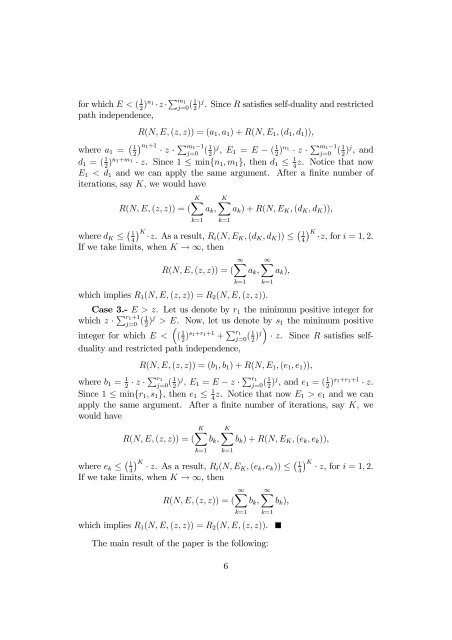THE TALMUD RULE AND THE SECUREMENT OF ... - ResearchGate
You also want an ePaper? Increase the reach of your titles
YUMPU automatically turns print PDFs into web optimized ePapers that Google loves.
for which EE. Now, let us denote by s 1 the minimum positive<br />
<br />
integer for which E< ( 1 2 )s 1+r 1 +1 + <br />
r 1<br />
j=0 ( 1 2 )j · z. Since R satisfies selfduality<br />
and restricted path independence,<br />
k=1<br />
k=1<br />
R(N,E,(z,z)) = (b 1 ,b 1 )+R(N,E 1 , (e 1 ,e 1 )),<br />
where b 1 = 1 · z · r 1<br />
2 j=0 ( 1 2 )j , E 1 = E − z · r 1<br />
j=0 ( 1 2 )j ,ande 1 =( 1 2 )s 1+r 1 +1 · z.<br />
Since 1 ≤ min{r 1 ,s 1 },thene 1 ≤ 1z. Notice that now E 4 1 >e 1 and we can<br />
apply the same argument. After a finite number of iterations, say K, we<br />
would have<br />
K K<br />
R(N,E,(z,z)) = ( b k , b k )+R(N,E K , (e k ,e k )),<br />
k=1<br />
k=1<br />
where e k ≤ K<br />
1<br />
· z. Asaresult,R<br />
4<br />
i (N,E K , (e k ,e k )) ≤ 1<br />
· z, fori =1, 2.<br />
4K<br />
If we take limits, when K →∞,then<br />
∞ ∞<br />
R(N,E,(z, z)) = ( b k , b k ),<br />
k=1<br />
which implies R 1 (N,E,(z,z)) = R 2 (N,E,(z, z)).<br />
The main result of the paper is the following:<br />
6<br />
k=1

















